An Akha woman near Chiang Rai, Thailand.
During the summers of 2003 and 2004, Som, Cokie and I road tripped throughout Thailand on two of our typically thematic trips. While of course we visited a few places that didn't exactly fit the "theme", these two expeditions were basically road trips that were geared toward experiencing Hill Tribe cultures in the northern and northwestern regions of Thailand.
We trekked the countryside and visited various hill tribe villages throughout the region. We visited villages of the Akha, Hmong, Lisu, Karen and Mien peoples who make their homes in northern Thailand. We visited their homes and sampled their food and drink. And we have since become very close friends with a Hmong family a couple hours outside of Chiang Mai who has welcomed my family and our groups to her home for cultural exchange, food and spirits!
I am very happy that my young boy has had an opportunity to learn more about these fascinating people and their cultures. He has played with their children and seen how they live their daily lives trhough direct experience. He has played their games and has learned how to give by selecting some of his own toys to offer as gifts to the young children.
In addition to the images that follow, log on to our Thailand Galleries:
Mammals of Thailand
Birds of Thailand
Temples and Ancient Sites of Thailand
Reptiles and Amphibians of Thailand
Lanscapes of Thailand
People of Thailand
The below are some of the images we have taken in northern and northwestern Thailand during our '03-'04 expeditions to Hill Tribe Country!

This Lisu gentleman was trying to sell us his lute. I have become somewhat of a collector of authentic hill tribe artifacts, mostly in the form of baskets. But I have found the hats and instruments interesting as well. We visited this gentleman's village one morning during a short road trip in to the countryside around Chiang Rai. We spent several days exploring the various hill tribes in the region about Chiang Rai. We also visited the so-called Golden Triangle as well as a trip in to Laos.

During our road trips, I would collect baskets all over the Thai countryside. I literally now have hundreds of baskets from all over Thailand. On this particular trip, I filled the back of our truck completely with dozens of baskets. Everytime we stopped long enough for people to see our baskets, a large crowd would form around the truck. We became used to hearing questions about why we had so many baskets. But this Lisu lady, through a translator, asked if she could have one of my baskets. She told us that she had never seen on like the one she is holding. This made sense to me as the basket she was holding was actually from Issan, the northeastern sector of Thailand. Of course I gave her the basket!
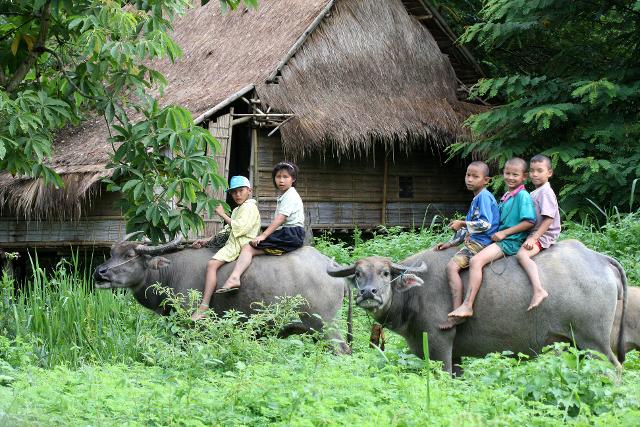
One very wet day while we were driving to Huai Kha Khaeng, we passed this lovely village with this surreal scene of all of these Lahu (I think) children riding their water buffaloes.

Although most of the opium crops have been replaced with other cash crops, such as roses and other flowers, one can still find heroine poppies in the more remote regions of the northwest.

A Mien lady sewing some tapestries to be sold at the local market near Chiang Mai.

About two hours out of Chiang Rai, heading toward the Myanmar border, we stopped off to see a village that was home to the long-neck Karen tribe. We spent an afternoon visiting their village that was located quite a bit off the main road. We met several of these amazingly striking people, who are known to be the most beautiful of all the hill tribes.

"Mom, never let your boy go to a Karen village!" This is the saying in northern Thailand about the Karen. Their beauty is known for being captivating and Thai families risk losing their sons to these women...or so the legend goes. This is our Mien driver during one of our earlier road trips in the region...becoming lost.

The Karen village near the Myanmar border. The Karen are in a very difficult position. With the genocide being perpetrated against them in their home country of Myanmar, they are left with only one option - escaping to Thailand. Som and I have visited some of the refugee camps located right on the border that were filled with millions of refugees. I will never forget seeing the teak-leaf thatched roofs of the huts stretching for miles in every direction. Consequently, the stateless Karen who actually get out of the refugee camps often find themselves being endentured servants to unscrupulous Thai who set up "Long Neck Hill Tribe" villages around the countryside. Alhtough I don't think that this particular village was of this type, we did see examples of these sorts of villages commonly in the countryside.
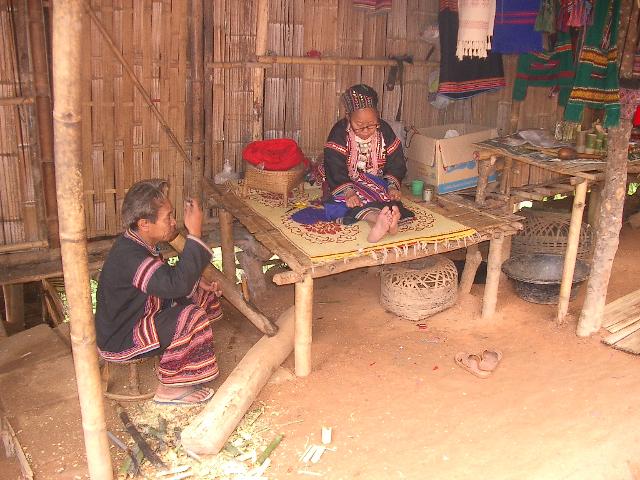
If you evern want to know the etymology of the word, "bong", it started here.

The Karen are a diverse tribe. Not all of the women are "long necked". This lady was sporting some amazing earrings.

The necks are not really long, the clavicles are compressed. Wow!

Spectacular.

Cokie and Som in an Akha market.

Cokie wearing his very own Akha hat.

Cokie spent time playing with this young Akha boy while we explored his village. We accidently found this village one day during a later road trip. This is how we did things. We saw a road, and took it until the end. Invariably we would happen across some of the most remote and spectacular villages that were generally way off the beaten tourist path.
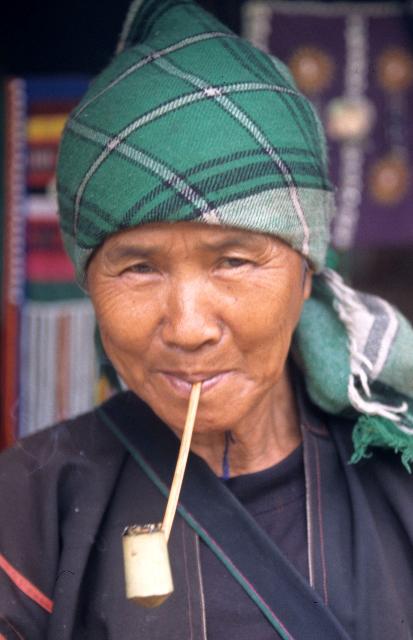
A Karen woman smoking her pipe!

Notice the stained teeth of this Akha woman. The stain is mostly due to the erica and betelnut.

Akha woman with their unique headdress.

Of all the headdresses in hill tribe country, the Akha definitely have the most ornate and spectacular.

Another Akha headdress.

Most of the coins on these headdresses are local and common or relatively inexpensive. Interestingly there have been many examples of coin collectors rumaging through the coin collections of the tribes and finding ancient Roman coins, proving the trade routes back in the day of Marco Polo and before reached all the way to this part of Southeast Asia!

Akha headdresses.

An Akha woman returning form a day's work. Women appear to do most of the work in most hill tribe societies.
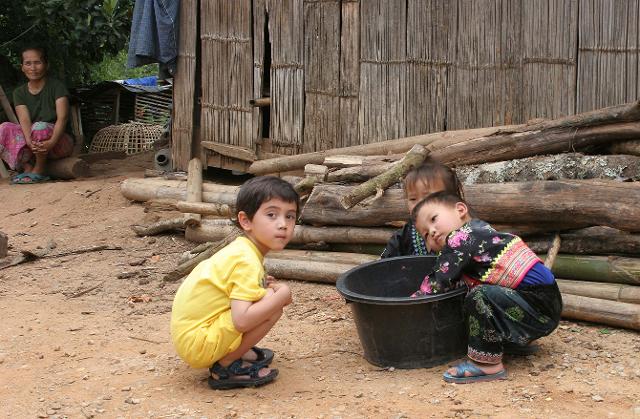
Cokie playing with some of his friends in Ying Mi's village near Mae Sa, a couple hours out of Chiang Mai. We "discovered" Ying Mi's village one afternoon while exploring hill tribe country and have been returning every year since. We have since become good friends with Ying Mi and her family. Cokie has been playing with her nieces and nephews for years now. Lucky boy.

On a rainy day in 2004, we came across Ying Mi's Hmong village and stopped for a spell to wait out the deluge of rain. This rain didn't seem to stop and we killed quite a lot of time in Ying Mi's makeshift noodle stand, which basically heated up water and served packaged ramen. While we sat and chatted with her. I had been thinking about bringing groups to Thailand for some time by this point and decided to ask if we could bring a group of farang tourists to her village to experience her food and culture. Som initially did not want to translate this as she thought we would never follow though. Little did she know we would eventually bring dozens of farang to see her village in the coming years! This is a photo of Ying Mi's grandmother who was initially reluctant to allow me to photograph her. Over time, she came to like me and allowed me to photograph the heck out of her! Her picture has now been published in newspapers the US!

On a later trip, I actually presented her a copy of a newspaper article with her in it. She and her family thought it was amazing. "Grandma's famous!"

Som with the fam!

Our first day meeting Ying Mi. As I was already an avid basket collector, I offered to buy her basket. She refused, saying it was her only basket and she needed it. I then asked how much it would cost to buy another basket and when the market was going to be held. She told me that it was about $5, and there was a market in a couple days. I then offered her $20 for her basket, more than enough to buy a new one the next day! She thought I was insane but she accepted. To me, even though it was a high price for a basket like this, it was worth every penny. Very few of the baskets I have in the collection have any connection with their owners. I bought them here and there from wholesalers and markets. But this was the first one I actually bought right off the back of the owner, who had to literally empty out its contents to sell to me! I felt a bit guilty, but Ying Mi definitely received a good deal. We still laugh about this to this day!

"Flat Stanley" in hill tribe country!
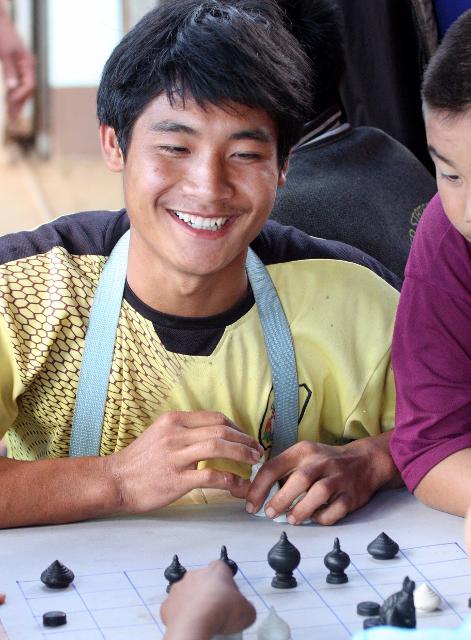
A friendly chess game, with Hmong rules.

This lady granted us the grand tour of her simple home! Fascinating!

This young Hmong girl near Wat Doi Suthep, has been seen during all of our trips to her village. Cokie is literally growing up with annual visits to see her! Hmmm....

"Spin the top" has a very different meaning when it becomes a Hmong New Year's competitive event! These bruts were slamming this high-speed top in to another already-spinning top that was launched by another player with precise accuracy.
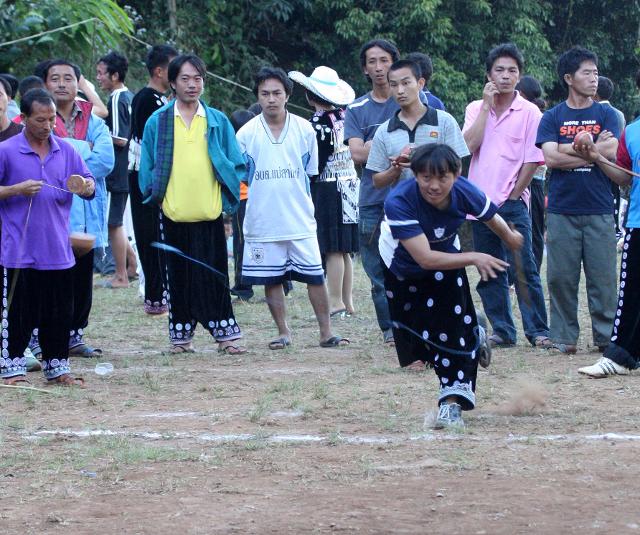
The level of accuracy was impressive.

To keep the top spinning, players would blow and spit on tip.

Money was changing hands but I could never figure how the betting went.
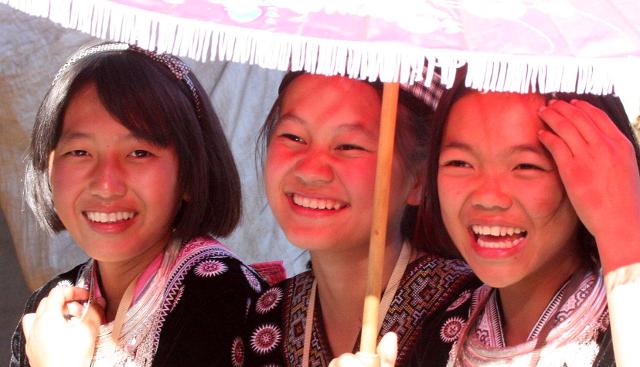
The following images are from a Hmong New Year's celebration we were invited to. What an amazing cultural event. I felt privileged to experience this event. My friends from the states initially felt a bit like we were intruding but after some time we all felt welcomed and part of the festivities. What a great day!

"Hey Farang! Wanna drink?"

Beautiful

I loved their cowboy hats!

I watched this lovely woman laugh and could not help taking some images. Spectacular.

I think she was laughing in embarrassment of having this big farang taking pictures of her!

During our visit, we were also witness to a traditional Hmong funeral. The day before our arrival, a young boy was killed with a hand grenade! The man with this lute was circling the home of the boy multiple times playing spiritual music and lighting very loud fire crackers to "instruct" the boy's spirit to leave the house!

A few minutes earlier, this cow was alive and walking the grounds near the house we were eating at. Talk about fresh!

Not surprisingly, Som was a fantastic shot with this!

Just one of the many sublime scenes and pastoral settings one passes when traveling in Hill Tribe Country. One late evening north of Mai Hong Son, we came across this amazing scene. We drove down a muddy road, turned off the truck and listened to the sounds of the countryside for the better part of an hour. Rich experience!

Brugmansia and other narcotics are still commonly found in Hill Tribe Country.

Cannibis gardens are also common.

Just some of my vast basket collection...

And some more....
In addition to the images that follow, log on to our Thailand Galleries:
Mammals of Thailand
Birds of Thailand
Temples and Ancient Sites of Thailand
Reptiles and Amphibians of Thailand
Lanscapes of Thailand
People of Thailand
